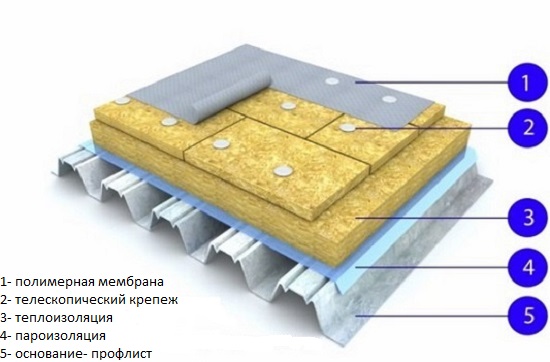
Membrane roofing is the most modern type of roofing. Its popularity is due to its excellent technological properties and the long service life of the topcoat. Due to its increased strength, resistance to moisture and excellent adhesion to all materials based on bitumen, such a roof is widely used in individual construction.
Content
Different types of membrane coatings
The use of polymeric materials and artificial rubber, which are flexible and elastic, allows you to create a roofing on the roofs of any plane and various slopes. Membrane roofing technology most often allows the use of the remarkable qualities of these materials on slightly sloping and flat roofs.
Today, various types of roofing membranes are produced. Let us dwell on three main ones.
PVC membrane. This coating has an excellent structure. It is based on the artificial material polyvinyl chloride, which has long been used in the production of insulating, finishing and other building materials.
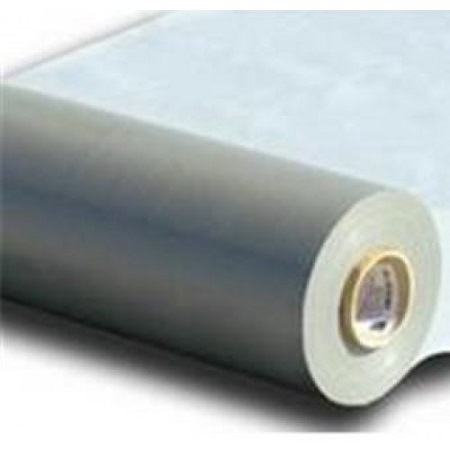
To increase the elasticity of the paintings, volatile plasticizers are added to the material. Thanks to the polyester reinforcing mesh, it gains additional flexibility and resilience. These properties remain indispensable when laying membranes on roofs that are notable for their complex configuration.
If we make a comparison, the PVC membrane roof is the most practical and cheap in relation to other types of rolled polymer roofing. Therefore, at the moment they are the most popular and in demand.
The advantages that distinguish this material from conventional roofing include the absence of unwanted leaks that occur due to the characteristics of various materials used for roofing.
As a rule, the joints of paintings do not fit tightly together, due to which moisture from the atmosphere gradually penetrates into the interior of buildings. Unlike other coatings, the PCB membrane roof, practically, has no seams. As a result, leaks on such a roof are minimized.

Among the advantages of the device of this type of roof can be considered the saving of labor and material resources. It does not need to create a technological layer of gravel, which is usually done with the device of the roof from traditional rolled materials.
Another advantage that a roof made of a PVC membrane has is its color. It is light, and therefore the roof reflects most of the sunlight falling on it. In the current heat, this is a tangible advantage.
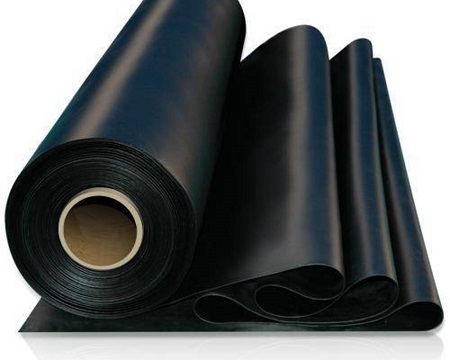
EPDM membrane. The basis of this material is artificial rubber - ethylene propylene diene monomer. The polymer mesh, with which the material is reinforced, gives it increased strength properties. This building material has a very long service life.
To increase the strength of the roof covering, the composition of EPDM membranes includes additives - polyester and modifying. Membranes have excellent adhesion properties (adhesion) with respect to materials based on bitumen. All this speaks of the remarkable waterproofing properties that the membrane roof has.
The cost of EPDM membranes for roofing is not cheap. But if you break down the price for the life of the roofing (more than 50 years), then it is unlikely to seem so high and unjustified.
TPO membrane. These membranes have come to the Russian market of waterproofing roofing coatings relatively recently. This roll coating includes several types of thermoplastic olefins.
Different manufacturers form the composition of their products according to the individual membrane formula and the ratio of polypropylene with ethylene propylene rubbers. More common is the membrane roof, the technology of which provides a ratio of 30% to 70%.
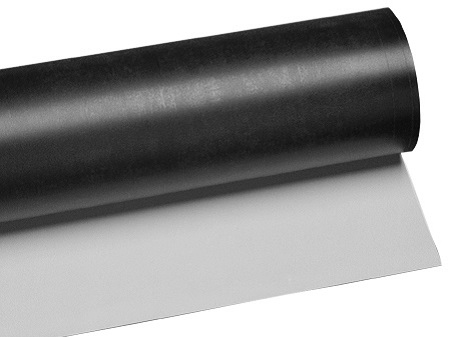
To increase strength and fire resistance in the production of this modern material, antioxidants and various stabilizing substances are added to its composition.
If we talk about the similarity of thermoplastic membrane roofs with their thermosetting analogues, then they are based on a completely different material - not rubber, but polyvinyl chloride or similar polymers.
Although the joining of PVC sheets does not occur by heating, their compaction is so tight that they do not allow water to pass through the seams calmly. Moreover, such materials for roof topcoat are more affordable (if we compare them with thermosetting analogues). The only negative is that they require ongoing maintenance and more frequent repairs to the membrane roof.
Today on the market there are two varieties of TPO membranes. One is reinforced with polyester, and the second is unreinforced, consisting of fiberglass.
The superdiffusion membranes of TechnoNicol have especially high quality. In these three-layer microporous membranes, the upper and lower layers consist of non-woven polypropylene. In the middle of such a strong frame is the so-called “working layer”. It consists of a polypropylene film with unique properties, due to which vapor diffusion occurs and, at the same time, an obstacle is created for the passage of water.
The middle layer, which contains the membrane roof of TechnoNicol, has excellent relative tensile properties. The non-woven propylene frame, which has high strength indicators, together with the middle layer, ensures the balance of the material in such indicators as resistance to mechanical stress and damage, excellent vapor permeability and water resistance. The layers in the superdiffuse membrane are connected using ultrasound, which is a guarantee of high stability of the material characteristics and eliminates the possibility of damage to the "working" middle layer. Membrane roofing of this type is safe and is not exposed to bacteria. The film is formed into rolls measuring 1.5 m by 0.5 meters.
The advantages of roofing membranes
The use of roofing membranes helps to achieve excellent waterproofing and thermal insulation performance of the finish coating. Conveniently, membranes can be laid on any type of foundation. The obvious and indisputable advantages of the material laying process is the quick implementation of installation work.

Membrane roofing is an ideal coating for low slope and flat roofs. This does not mean that it cannot be laid on roofs with complex geometry.
When repairing the roof using membrane materials, the need to dismantle the old damaged roofing disappears. It is difficult to disagree that this situation will significantly reduce labor costs and reduce the cost of construction work.
The main thing that includes repairing the membrane roof is cleaning the base of the roof from debris. After that, the geotextile fabric is spread in two layers. It is intended to protect the coating from damage.Then the roof is sealed in strict accordance with the technology of roofing.
Polymeric membrane materials have undeniable advantages, for example, they
- exhibit thermal stability with respect to daily and seasonal temperature differences;
- have high elasticity, ductility and tensile strength;
- provide a minimum number of joints;
- can be used on roofs with a complex and non-standard configuration;
- membrane roofing can be carried out in the shortest possible time.
Since the roofing membrane has high quality indicators, modern construction has successfully applied this popular material.
Installation of roofing membranes
The fastening of the thermosetting web to the base of the roof is carried out mechanically, after which, using special equipment, the joints are heated with hot air. Then the canvases are welded together with an overlap method.
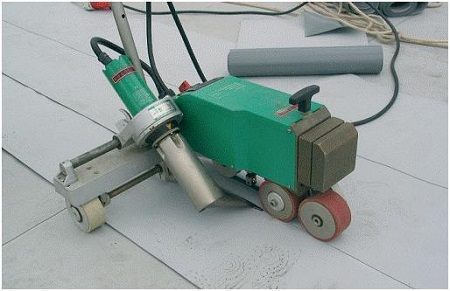
Repair of the membrane roof reliably fixes the membrane sheet on the roof, while ensuring the highest level of waterproofing of the entire finish.
Due to the fact that the membrane panels are not very tight to the base, excellent ventilation is ensured between the two layers of the roof. Since there is no settling of the formed condensate, there is no need for a waterproofing subroofing membrane.
In places where the finish coating is adjacent to other elements of the roof (podiums, fillet seams, parapets), a heat gun is used for its installation. Such simple equipment for membrane roofing is also used in hard-to-reach places for processing joints.

It is necessary to be careful and correctly carry out all technological operations for the installation of membranes. If work is carried out with violations, then the consequences may be the worst, for example, depressurization of joints may occur.
If the work is carried out on industrial, warehouse buildings and metal structures, when profiled sheets are used as the basis for coating, before coating the roof with membranes, a rubber-bitumen emulsion or rubber-based mastic is applied to them. With this approach, the membrane roof receives additional waterproofing.
Mounting and mounting options for membranes can be as follows:
- The roof area is filled with a ballast layer of crushed stone, gravel and other materials.
- The coating is mechanically fixed to the base of the roof using “rucksacks”.
- The membrane of the roof is attached using adhesive compounds.
Installation of a thermoplastic membrane roof is performed differently than its thermosetting analogue.
Installation sequence
-
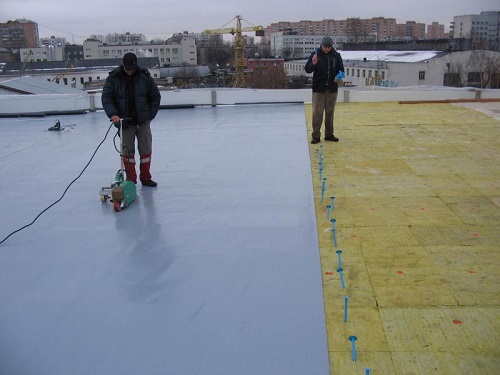
Membrane roofing Membrane roofing begins with preparatory work for cleaning garbage, dismantling additional elements, which include antennas, transition ladders, lightning rods, signs, etc.
- It may be necessary to partially dismantle the old roofing, seal the destroyed sections of the roof, level it, dry out wet places, etc.
- The device of special drainage with the help of geotextiles and additional insulation, for which they use rigid basalt cotton wool or extruded polystyrene foam.
- Direct laying of the roll coating, which does not require heating joints.
The membrane roof, which you will do with your own hands, will reliably protect your roof and will last for 20-30 years. This type of coating does not need additional waterproofing, since it itself is very resistant to moisture.
Compared with conventional roll materials, the installation of a membrane roof can be done in the shortest possible time.

Roof repair with the use of coatings of this type requires certain knowledge and ability to handle welding equipment.If you are not confident in your own skills, it is better to entrust the work to professional masters.

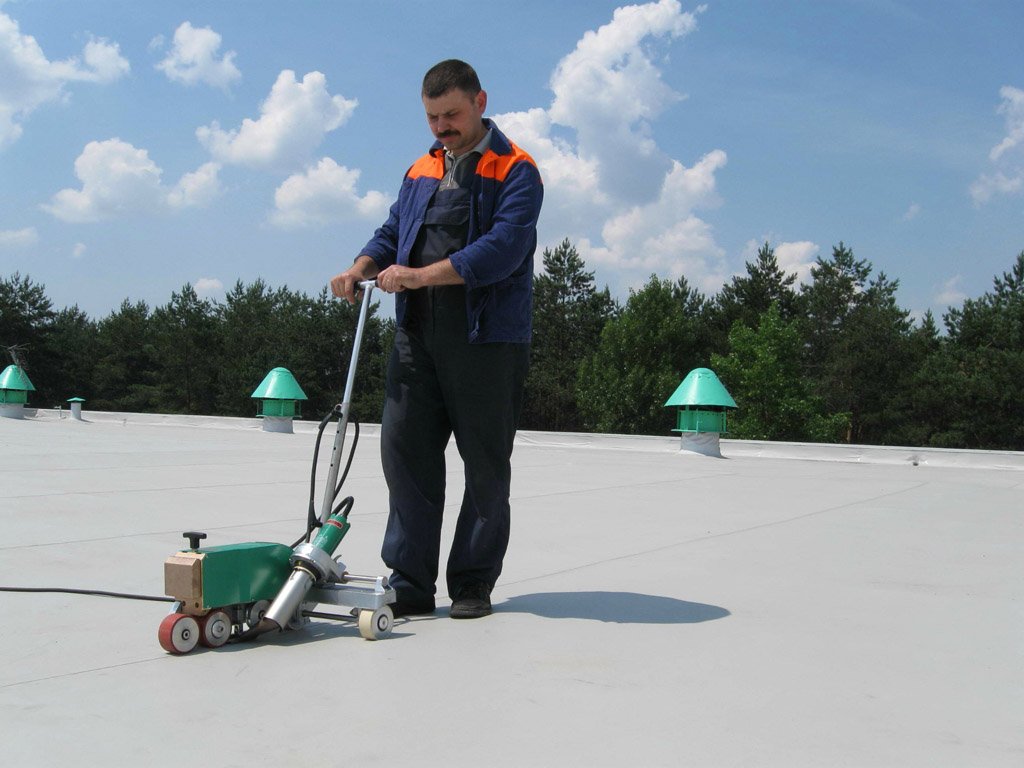



Alas, no comments yet. Be the first!